
Zulfiqar Hasan, Associate Professor (Finance)
Topic Contents: Definition of Corporate Financial Planning, Planning Horizon,, elements of financial planning, Scenario Analysis in Corporate Financial Planning, Role of Corporate Financial Planning Growth: Determinants of Growth; Internal growth rate, sustainable growth rate, calculation of growth rate; percentage of sales method, Pro-forma Statement
What is Corporate Financial Planning?
In general usage, a financial plan can be a budget, a plan for spending and saving future income. This plan allocates future income to various types of expenses, such as rent or utilities, and also reserves some income for short-term and long-term savings.
Financial planning is the task of determining how a business will afford to achieve its strategic goals and objectives.
Corporate Financial Planning is the method by which financial goals are to be achieved. Financial planning is the process of successfully meeting financial needs of life through the proper management of finances.
Corporate Financial Planning is the process of determining a company's financial needs or goals for the future and how to achieve them. Corporate financial planning involves deciding what investments and activities would be most appropriate under both the company's individual and broader economic circumstances. All things being equal, short-term financial planning involves less uncertainty than long-term financial planning because, generally speaking, market trends are more easily predictable in the short term. Likewise, short-term financial plans are more easily amendable in case something goes wrong.
It is the roadmap to Financial Health, & Sustainable Wealth creation.
Financial Planning Process
- Planning Time Horizon: divide decisions into short-run decisions (usually next 12 months) and long-run decisions (usually 2 – 5 years)
- Level of Aggregation: combine capital budgeting decisions into one big project
- Assumptions and Scenarios: Make realistic assumptions about important variables. Run several scenarios where you vary the assumptions by reasonable amounts. Determine at least a worst case, normal case, and best case scenario
Financial Planning Model Ingredients
- Sales Forecast: many cash flows depend directly on the level of sales (often estimated using sales growth rate)
- Pro Forma Statements: setting up the plan using projected financial statements allows for consistency and ease of interpretation
- Asset Requirements: the additional assets that will be required to meet sales projections
- Financial Requirements: the amount of financing needed to pay for the required assets
- Plug Variable: determined by management deciding what type of financing will be used to make the balance sheet balance
- Economic Assumptions: explicit assumptions about the coming economic environment
Scenario Analysis in Corporate Financial Planning
Each division might be asked to prepare three different plans for the near term future:
- A Worst Case: This plan would require making the worst possible assumptions about the company’s products and the state of the economy. It could mean divestiture and liquidation.
- A Normal Case: This plan would require making the most likely assumptions about the company and the economy.
- A Best Case: Each division would be required to work out a case based on the most optimistic assumptions. It could involve new products and expansion.
Role of Corporate Financial Planning
- Examine interactions: help management see the interactions between decisions. The plan must make explicit the linkages between investment proposals and the firm’s financing choices
- Explore options: give management a systematic framework for exploring its opportunities. The plan provides an opportunity for the firm to weigh its various options
- Avoid surprises: help management identify possible outcomes and plan accordingly. Nobody plans to fail, but many fail to plan
- Ensure feasibility and internal consistency: help management determine if goals can be accomplished and if the various stated (and unstated) goals of the firm are consistent with one another. The different plans must fit into the overall corporate objective of maximizing shareholder wealth
Why do you think most long-term financial planning begins with sales forecasts? Put differently, why are future sales the key input?
The reason is that, ultimately, sales are the driving force behind a business. A firm’s assets, employees, and, in fact, just about every aspect of its operations and financing exist to directly or indirectly support sales. Put differently, a firm’s future need for things like capital assets, employees, inventory, and financing are determined by its future sales level.
What Determines Growth?
Firms frequently make growth forecasts on explicit part of financial planning. On the other hand, the focus of this course has been on shareholder wealth maximization, often expressed through the NPV criterion.
One way to reconcile the two is to think of growth as an intermediate goal that leads to higher value.
Alternatively, if the firm is willing to accept negative NPV projects just to grow in size, the shareholders (but not necessarily the mangers) will be worse off.
Determinants of Growth
- Profit margin: An increase in profit margin will increase the firm’s ability to generate funds internally and thereby increase its sustainable growth.
- Dividend policy: A decrease in the percentage of net income paid out as dividends will increase the retention ratio. This increases internally generated equity and thus increases sustainable growth.
- Financial policy: An increase in the debt-equity ratio increases the firm’s financial leverage. Because this makes additional debt financing available, it increases the sustainable growth rate.
- Total asset turnover: An increase in the firm’s total asset turnover increases the sales generated for each dollar in assets. This decreases the firm’s need for new assets as sales grow and thereby increases the sustainable growth rate.
Needed Formula in this Topic
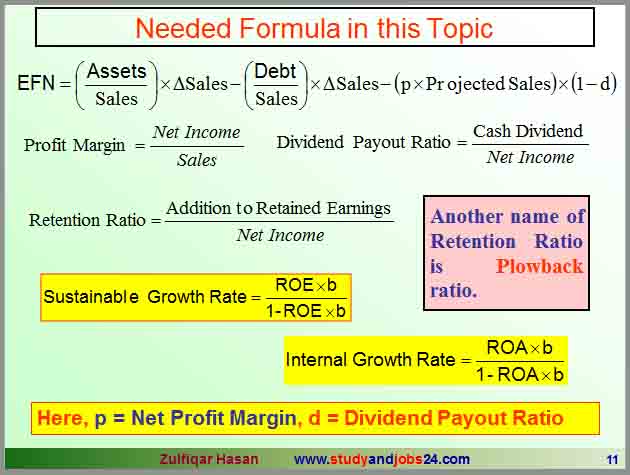
Recalling the Ratios
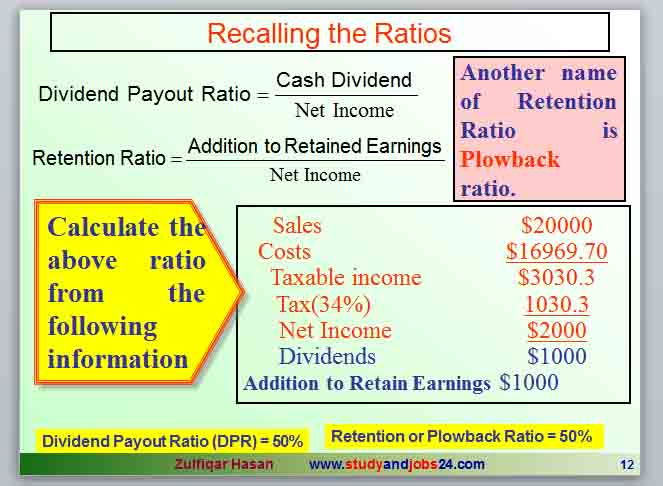
Example 01: Determining the EFN
Based on the following information for the Skandia Mining Company,
- What is EFN if sales are predicted to grow by 10%? Use the percentage of sales approach and assume the company is operating at full capacity. The payout ratio is constant.
- What growth rate can Skandia maintain if no external financing is used? What is the sustainable growth rate?
|
Income Statement |
Balance Sheet |
||||
|
Sales |
$4250 |
CA |
$900 |
CL |
$500 |
|
Costs |
3875 |
FA |
2200 |
LT Debt |
1800 |
|
Taxable Income |
$375 |
Equity |
800 |
||
|
Taxes (34%) |
127.5 |
Total |
$3100 |
Total L & OE |
3100 |
|
Net Income |
$247.5 |
||||
|
Dividends |
82.6 |
||||
|
R/E |
164.9 |
||||
Solution: Determining the EFN
01. We can calculate the EFN by preparing the pro forma statements using the percentage of sales approach..
The forecasted sales are = $4250 (1.10) = $4675
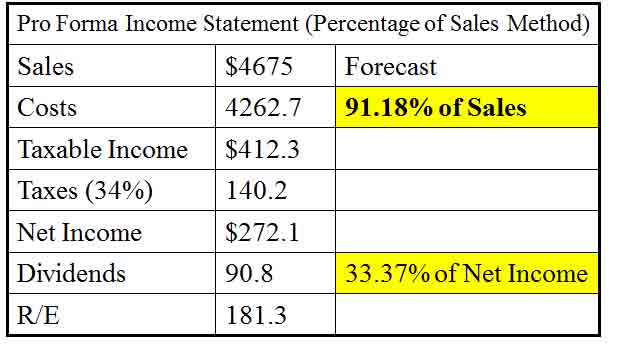
|
Pro Forma Balance Sheet |
|||||
|
Assets |
Liabilities and Owners Equity |
||||
|
CA |
990 |
21.18% |
CL |
550 |
11.76% |
|
FA |
2420 |
51.76% |
LT Debt |
1800 |
|
|
TA |
3410 |
72.94% |
Equity |
981.3 |
|
|
Total L and OE |
3331.3 |
||||
|
EFN |
78.7 |
||||
02. Using the old original statement
Retention Ratio, b =1-0.3337 = 66.63%
Return on assets = $247.5/3100 = 7.89%
The internal growth rate is:
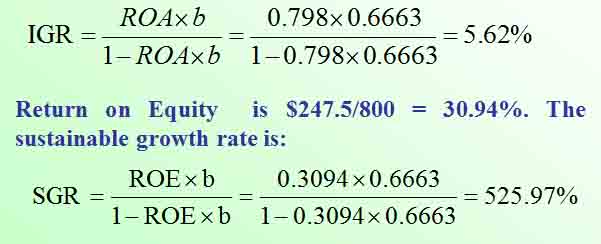
Recalling the Ratios
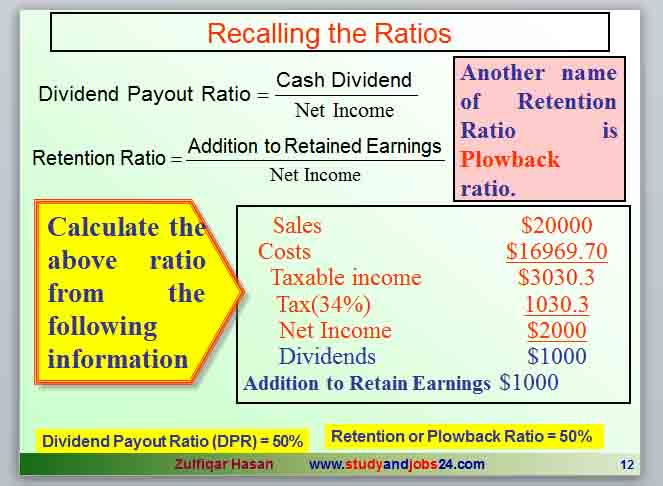
Example 02: Pro Forma Statements & Plug Variable
Consider the following simplified financial statements for the Lafferty Ranch Corporation (assuming no income taxes):
|
Lafferty Ranch has predicted a sales increase of 10 percent. It has predicted that every item on the balance sheet will increase by 10% as well. Create the pro forma statements and reconcile them. What is the plug variable here?
Solution: Pro Forma Statements
Pro Forma Income Statement Pro Forma Balance Sheet
Sales $17600 Assets $9790 Debt $5610
Costs 13750 Equity 4180
Net income $ 3850 Total $9790 Total $9790
Equity = Total Liabilities & Equity- Debt
Equity = $9790-$5610 = $4180;
So Equity increase = $4180-$3800= $380
Net Income is $3850, but equity only increased by $380; therefore, a dividend of-
Dividend = $3850-$380 = $3470 must have been paid is the plug variable.
(It is important to remember that equity will not increase by the same percentage as the other assets. If every other item on the income statement and balance sheet increases by 10 percent, the pro forma income statement and balance sheet will look like this)
Practice 01: Pro Forma Statements
Consider the following simplified financial statements for the Lafferty Ranch Corporation (assuming no income taxes):
Income Statement Balance Sheet
Sales $15,000 Assets $4300 Debt $2800
Costs 11000 Equity 1500
Net income $ 4000 Total $4300 Total $4300
Lafferty Ranch has predicted a sales increase of 10 percent. It has predicted that every item on the balance sheet will increase by 10 percent as well. Create the pro forma statements and reconcile them. What is the plug variable here?
Example 02: EFN
The most recent financial statements for Bradley’s Bagels, Inc., are shown here (assuming no income taxes):
Income Statement Balance Sheet
Sales $3800 Assets $13300 Debt $9200
Costs $1710 Equity 4100
Net income $ 2090 Total $13300 Total $13300
Assets and costs are proportional to sales. Debt and equity are not. No dividends are paid. Next year’s sales are projected to be $5,320.
- What will be new equity?
- What is the external financing needed?
Solution: Example - 02 EFN
An increase of sales to $5,320 is an increase of:
Sales increase = ($5320 – $3800) / $3800
Sales increase = .40 or 40%
Assuming costs and assets increase proportionately, the pro forma financial statements will look like this:
Proforma Income Statement Proforma Balance Sheet
Sales $5320 Assets $18620 Debt $9200
Costs $2394 Equity 4100
Net income $ 2926 Total $18620 Total $13300
If no dividends are paid, the equity account will increase by the net income, so:
Equity = $4,100 + $2926
Equity = $7026
So the EFN is:
EFN = Total assets – Total liabilities and equity
EFN = $18620 – 13300 = $5320
Practice 02: EFN
The most recent financial statements for Bradley’s Bagels, Inc., are shown here (assuming no income taxes):
Income Statement Balance Sheet
Sales $5320 Assets $18620 Debt $12520
Costs $2394 Equity 6100
Net income $ 2926 Total $18620 Total $18620
Assets and costs are proportional to sales. Debt and equity are not. No dividends are paid. Next year’s sales are projected to be $7500.
- What will be new equity?
- What is the external financing needed?
Growth and External Financing
At low growth levels, internal financing (retained earnings) may exceed the required investment in assets
As the growth rate increases, the internal financing will not be enough and the firm will have to go to the capital markets for money
Examining the relationship between growth and external financing required is a useful tool in long-range planning
The Internal Growth Rate
The internal growth rate tells us how much the firm can grow assets using retained earnings as the only source of financing.
Relying solely on internally generated funds will increase equity (retained earnings are part of equity) and assets without an increase in debt. Consequently, the firm’s leverage will decrease over time. If there is an optimal amount of leverage, as we will discuss in later chapters, then the firm may want to borrow to maintain that optimal level of leverage. This idea leads us to the sustainable growth rate.
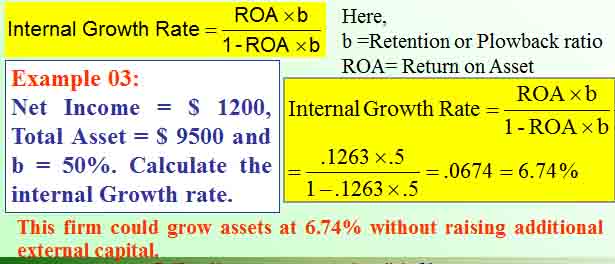
Practice 03: Internal Growth Rate
A company’s net income was Tk 66 and Total assets were Tk 500. Of the Tk 66 net income, Tk 44 was retained. Calculate the followings:
- Return on Assets (ROA)
- Retention or Plowback Ratio
- Internal Growth Rate
Answer:
Return on Assets (ROA) = 13.2%
Retention or Plowback Ratio= 66.67%
Internal Growth Rate= 9.65%
The Sustainable Growth Rate
The sustainable growth rate is the maximum growth rate that a firm can achieved with no external equity financing while maintaining a constant debt-equity ratio.

The sustainable growth rate is a measure of how much a firm can grow without borrowing more money. After the firm has passed this rate, it must borrow funds from another source to facilitate growth. The maximum growth rate that a firm can sustain without having to increase financial leverage.
Increasing The Sustainable growth rate
A firm can do several things to increase its sustainable growth rate:
- Sell new shares of stock
- Increase its reliance on debt
- Reduce its dividend-payout ratio
- Increase profit margins
- Decrease its asset-requirement ratio
Uses of the Sustainable Growth Rate
- A good use of the sustainable growth rate is to compare a firm’s sustainable growth rate with their actual growth rate to determine if there is a balance between growth and profitability.
- A commercial lender would want to compare a potential borrower’s actual growth rate with their sustainable growth rate.
- If the actual growth rate is much higher than the sustainable growth rate, the borrower runs the risk of “growing broke” and any lending must be viewed as a down payment on a much more comprehensive lending arrangement than just one round of financing.
Example 04: Sustainable Growth Rate
Calculate Sustainable Growth rate from the following information:
ROE = 1200 / 4100 = .2927 and b = 0.50
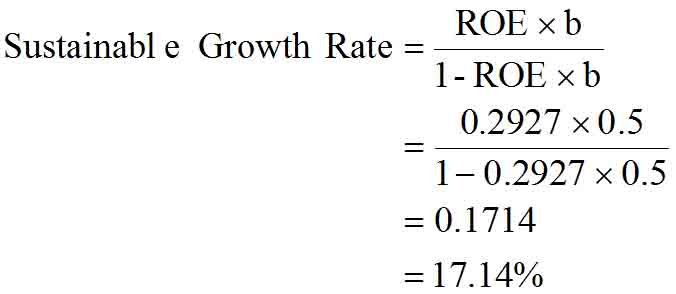
The sustainable growth rate is substantially higher than the internal growth rate. This is because we are allowing the company to issue debt as well as use internal funds.
Practice 04: Sustainable Growth Rate
Given that, Net Income = $66; Total Equity = $250; Plowback Ratio = 2/3
Calculate Sustainable Growth Rate.
Answer:
Return on Equity (ROE) = 26.4%
Sustainable Growth Rate= 21.36%
Integrated Practice 01
Observe the following financial statements:
|
Income Statement |
Balance Sheet |
||||
|
Sales |
BDT 50000 |
Current assets |
BDT 30000 |
Debt |
BDT 45000 |
|
Costs |
BDT 24000 |
Fixed assets |
BDT 70000 |
Equity |
BDT 55000 |
|
Taxable Income |
BDT 26000 |
Total |
BDT 100000 |
Total |
BDT 100000 |
|
Taxes @40% |
BDT 10400 |
||||
|
Net Income |
BDT 15600 |
||||
|
Dividend |
BDT 8600 |
||||
Calculate the followings:
Example
The most recent financial statements for Barely Heroes Co. are shown here:
|
Income Statement |
Balance Sheet |
||||
|
Sales |
$8750 |
Current assets |
$11300 |
Debt |
$24900 |
|
Costs |
$4500 |
Fixed assets |
$31000 |
Equity |
$17400 |
|
Taxable Income |
$4250 |
Total |
$42300 |
Total |
42300 |
|
Taxes (34%) |
$1445 |
||||
|
Net Income |
$2805 |
||||
Assets and costs are proportional to sales. Debt and equity are not. Barely Heroes maintains a constant 20% dividend payout ratio. No external equity Financing is possible.
Solution: Example
Calculating the internal growth rate
ROA = NI / TA
ROA = $2,805 / $42,300= 0.0663 = 6.63%
The plowback ratio, b, is one minus the payout ratio, so:
b = 1 – 0.20 =0 .80
Now; Internal growth rate = (ROA × b) / [1 – (ROA × b)]
Internal growth rate = [0.0663(.80)] / [1 – 0.0663(.80)]
=.0560 or 5.60%
Calculating the sustainable growth rate
ROE = NI / TE
ROE = $2,805 / $17,400 = .1612 or 16.12%
The plowback ratio, b = 1 – .20 = 0 .80
Now we can use the sustainable growth rate equation to get:
Sustainable growth rate = (ROE × b) / [1 – (ROE × b)]
Sustainable growth rate = [0.1612(.80)] / [1 – 0.1612(.80)]
Sustainable growth rate = .1481 or 14.81%
Practice 05
The most recent financial statements for Barely Heroes Co. are shown here:
|
Income Statement |
Balance Sheet |
||||
|
Sales |
$6475 |
Current assets |
$9000 |
Debt |
$22000 |
|
Costs |
3981 |
Fixed assets |
25000 |
Equity |
12000 |
|
Taxable Income |
$2494 |
Total |
$34000 |
Total |
34000 |
|
Taxes (34%) |
848 |
||||
|
Net Income |
$1646 |
||||
Assets and costs are proportional to sales. Debt and equity are not. Barely Heroes maintains a constant 20% dividend payout ratio. No external equity Financing is possible.
Practice 06: Sustainable growth
The Stieben Company has determined that the following will be true next year:
Ratio of total asset to sales=1,
Net profit margin on sale =5%,
Dividend Payout Ratio =50% ,
Debt Equity Ratio=1
- What is Stieben’s sustainable growth rate in sales ?
- Can Stieben’s actual growth rate in sales be different from it’s sustainable growth rate ?
- How can Stieben change its sustainable growth?
Practice 07 : Sustainable Growth Rate
The MBI Company does not want to grow. The Company’s financial management believes it has no positive NPV projects. The Company’s operating financial characteristics are
Profit margin=10%,
Assets-sales ratio=150%
Debt-equity ratio=100%
Dividend-payout ratio=50%
- Calculate the sustainable growth rate for the MBI company.
- How can the MBI company achieve its stated growth goal?
Practice 08 : Sustainable Growth Rate
Your firm recently hired a new MBA. She Insist that your firm is incorrectly computing its sustainable growth rate .Your firm computes the sustainable growth rate using the following formula: p x (1-d) x (1-L)/ T-P x (1-d) x (1-L)
T=Ratio of total asset to sales, P= Net profit margin on sale,d= Dividend payout ratio, L=Debt equity ratio.
Your new employee claims that the correct formula is ROE x (1-d) where ROE is net profit divided by net worth and d is dividends divided by net profit. Is you new employee correct?
Preparation
- Try to answer all Concept Check questions given within the chapter.
- Try to solve all relevant problems given at the end of chapter.
- Relate all theoretical concept in Bangladesh concept
Please share for other students and learners. Click here to like and visit our facebook page.




